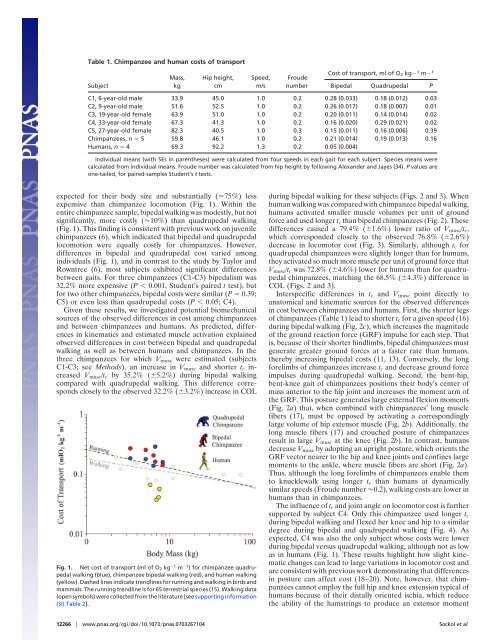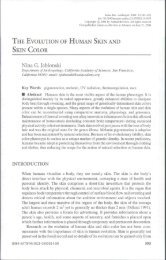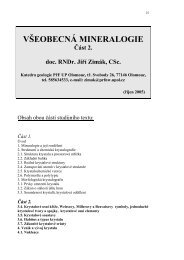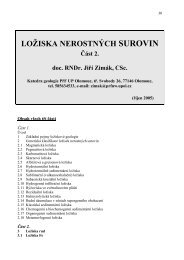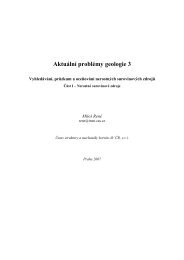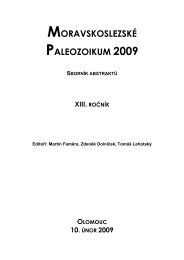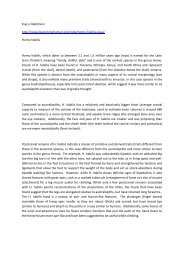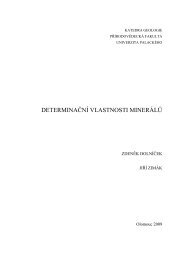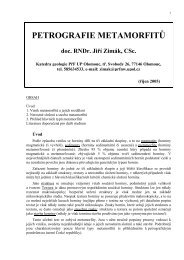Chimpanzee locomotor energetics and the origin of human bipedalism
Chimpanzee locomotor energetics and the origin of human bipedalism
Chimpanzee locomotor energetics and the origin of human bipedalism
You also want an ePaper? Increase the reach of your titles
YUMPU automatically turns print PDFs into web optimized ePapers that Google loves.
Table 1. <strong>Chimpanzee</strong> <strong>and</strong> <strong>human</strong> costs <strong>of</strong> transport<br />
Subject<br />
Mass,<br />
kg<br />
Hip height,<br />
cm<br />
Speed,<br />
m/s<br />
Froude<br />
number<br />
Cost <strong>of</strong> transport, ml <strong>of</strong> O 2 kg 1 m 1<br />
Bipedal Quadrupedal P<br />
C1, 6-year-old male 33.9 45.0 1.0 0.2 0.28 (0.033) 0.18 (0.012) 0.03<br />
C2, 9-year-old male 51.6 52.5 1.0 0.2 0.26 (0.017) 0.18 (0.007) 0.01<br />
C3, 19-year-old female 63.9 51.0 1.0 0.2 0.20 (0.011) 0.14 (0.014) 0.02<br />
C4, 33-year-old female 67.3 41.3 1.0 0.2 0.16 (0.020) 0.29 (0.021) 0.02<br />
C5, 27-year-old female 82.3 40.5 1.0 0.3 0.15 (0.011) 0.16 (0.006) 0.39<br />
<strong>Chimpanzee</strong>s, n 5 59.8 46.1 1.0 0.2 0.21 (0.014) 0.19 (0.013) 0.16<br />
Humans, n 4 69.3 92.2 1.3 0.2 0.05 (0.004)<br />
Individual means (with SEs in paren<strong>the</strong>ses) were calculated from four speeds in each gait for each subject. Species means were<br />
calculated from individual means. Froude number was calculated from hip height by following Alex<strong>and</strong>er <strong>and</strong> Jayes (34). P values are<br />
one-tailed, for paired-samples Student’s t tests.<br />
expected for <strong>the</strong>ir body size <strong>and</strong> substantially (75%) less<br />
expensive than chimpanzee locomotion (Fig. 1). Within <strong>the</strong><br />
entire chimpanzee sample, bipedal walking was modestly, but not<br />
significantly, more costly (10%) than quadrupedal walking<br />
(Fig. 1). This finding is consistent with previous work on juvenile<br />
chimpanzees (6), which indicated that bipedal <strong>and</strong> quadrupedal<br />
locomotion were equally costly for chimpanzees. However,<br />
differences in bipedal <strong>and</strong> quadrupedal cost varied among<br />
individuals (Fig. 1), <strong>and</strong> in contrast to <strong>the</strong> study by Taylor <strong>and</strong><br />
Rowntree (6), most subjects exhibited significant differences<br />
between gaits. For three chimpanzees (C1-C3) <strong>bipedalism</strong> was<br />
32.2% more expensive (P 0.001, Student’s paired t test), but<br />
for two o<strong>the</strong>r chimpanzees, bipedal costs were similar (P 0.39;<br />
C5) or even less than quadrupedal costs (P 0.05; C4).<br />
Given <strong>the</strong>se results, we investigated potential biomechanical<br />
sources <strong>of</strong> <strong>the</strong> observed differences in cost among chimpanzees<br />
<strong>and</strong> between chimpanzees <strong>and</strong> <strong>human</strong>s. As predicted, differences<br />
in kinematics <strong>and</strong> estimated muscle activation explained<br />
observed differences in cost between bipedal <strong>and</strong> quadrupedal<br />
walking as well as between <strong>human</strong>s <strong>and</strong> chimpanzees. In <strong>the</strong><br />
three chimpanzees for which V musc were estimated (subjects<br />
C1-C3; see Methods), an increase in V musc <strong>and</strong> shorter t c increased<br />
V musc /t c by 35.2% (5.2%) during bipedal walking<br />
compared with quadrupedal walking. This difference corresponds<br />
closely to <strong>the</strong> observed 32.2% (3.2%) increase in COL<br />
Fig. 1. Net cost <strong>of</strong> transport (ml <strong>of</strong> O 2 kg 1 m 1 ) for chimpanzee quadrupedal<br />
walking (blue), chimpanzee bipedal walking (red), <strong>and</strong> <strong>human</strong> walking<br />
(yellow). Dashed lines indicate trendlines for running <strong>and</strong> walking in birds <strong>and</strong><br />
mammals. The running trendline is for 65 terrestrial species (15). Walking data<br />
(open symbols) were collected from <strong>the</strong> literature [see supporting information<br />
(SI) Table 2].<br />
during bipedal walking for <strong>the</strong>se subjects (Figs. 2 <strong>and</strong> 3). When<br />
<strong>human</strong> walking was compared with chimpanzee bipedal walking,<br />
<strong>human</strong>s activated smaller muscle volumes per unit <strong>of</strong> ground<br />
force <strong>and</strong> used longer t c than bipedal chimpanzees (Fig. 2). These<br />
differences caused a 79.4% (1.6%) lower ratio <strong>of</strong> V musc /t c ,<br />
which corresponded closely to <strong>the</strong> observed 76.8% (2.6%)<br />
decrease in <strong>locomotor</strong> cost (Fig. 3). Similarly, although t c for<br />
quadrupedal chimpanzees were slightly longer than for <strong>human</strong>s,<br />
<strong>the</strong>y activated so much more muscle per unit <strong>of</strong> ground force that<br />
V musc /t c was 72.8% (4.6%) lower for <strong>human</strong>s than for quadrupedal<br />
chimpanzees, matching <strong>the</strong> 68.5% (4.3%) difference in<br />
COL (Figs. 2 <strong>and</strong> 3).<br />
Interspecific differences in t c <strong>and</strong> V musc point directly to<br />
anatomical <strong>and</strong> kinematic sources for <strong>the</strong> observed differences<br />
in cost between chimpanzees <strong>and</strong> <strong>human</strong>s. First, <strong>the</strong> shorter legs<br />
<strong>of</strong> chimpanzees (Table 1) lead to shorter t c for a given speed (16)<br />
during bipedal walking (Fig. 2c), which increases <strong>the</strong> magnitude<br />
<strong>of</strong> <strong>the</strong> ground reaction force (GRF) impulse for each step. That<br />
is, because <strong>of</strong> <strong>the</strong>ir shorter hindlimbs, bipedal chimpanzees must<br />
generate greater ground forces at a faster rate than <strong>human</strong>s,<br />
<strong>the</strong>reby increasing bipedal costs (11, 13). Conversely, <strong>the</strong> long<br />
forelimbs <strong>of</strong> chimpanzees increase t c <strong>and</strong> decrease ground force<br />
impulses during quadrupedal walking. Second, <strong>the</strong> bent-hip,<br />
bent-knee gait <strong>of</strong> chimpanzees positions <strong>the</strong>ir body’s center <strong>of</strong><br />
mass anterior to <strong>the</strong> hip joint <strong>and</strong> increases <strong>the</strong> moment arm <strong>of</strong><br />
<strong>the</strong> GRF. This posture generates large external flexion moments<br />
(Fig. 2a) that, when combined with chimpanzees’ long muscle<br />
fibers (17), must be opposed by activating a correspondingly<br />
large volume <strong>of</strong> hip extensor muscle (Fig. 2b). Additionally, <strong>the</strong><br />
long muscle fibers (17) <strong>and</strong> crouched posture <strong>of</strong> chimpanzees<br />
result in large V musc at <strong>the</strong> knee (Fig. 2b). In contrast, <strong>human</strong>s<br />
decrease V musc by adopting an upright posture, which orients <strong>the</strong><br />
GRF vector nearer to <strong>the</strong> hip <strong>and</strong> knee joints <strong>and</strong> confines large<br />
moments to <strong>the</strong> ankle, where muscle fibers are short (Fig. 2a).<br />
Thus, although <strong>the</strong> long forelimbs <strong>of</strong> chimpanzees enable <strong>the</strong>m<br />
to knucklewalk using longer t c than <strong>human</strong>s at dynamically<br />
similar speeds (Froude number 0.2), walking costs are lower in<br />
<strong>human</strong>s than in chimpanzees.<br />
The influence <strong>of</strong> t c <strong>and</strong> joint angle on <strong>locomotor</strong> cost is fur<strong>the</strong>r<br />
supported by subject C4. Only this chimpanzee used longer t c<br />
during bipedal walking <strong>and</strong> flexed her knee <strong>and</strong> hip to a similar<br />
degree during bipedal <strong>and</strong> quadrupedal walking (Fig. 4). As<br />
expected, C4 was also <strong>the</strong> only subject whose costs were lower<br />
during bipedal versus quadrupedal walking, although not as low<br />
as in <strong>human</strong>s (Fig. 1). These results highlight how slight kinematic<br />
changes can lead to large variations in <strong>locomotor</strong> cost <strong>and</strong><br />
are consistent with previous work demonstrating that differences<br />
in posture can affect cost (18–20). Note, however, that chimpanzees<br />
cannot employ <strong>the</strong> full hip <strong>and</strong> knee extension typical <strong>of</strong><br />
<strong>human</strong>s because <strong>of</strong> <strong>the</strong>ir distally oriented ischia, which reduce<br />
<strong>the</strong> ability <strong>of</strong> <strong>the</strong> hamstrings to produce an extensor moment<br />
12266 www.pnas.orgcgidoi10.1073pnas.0703267104 Sockol et al.


